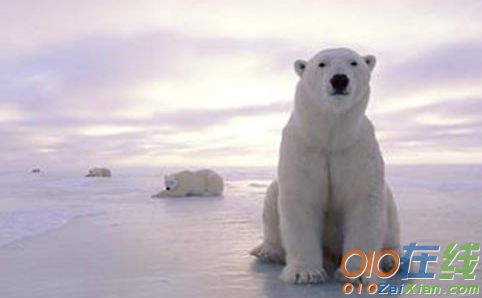北极熊,是世界上最大的陆地食肉动物,又名白熊。下面是小编分享的描写濒临危机动物的英语作文北极熊,欢迎大家阅读!

写濒临危机动物的英语作文北极熊篇一:
When the Arctic Ocean freezes over in the autumn, polar bears set off in search of their favorite meals: fatty ringed seals and bearded seals. By the summer, the sea ice begins to melt and break apart. Deprived of access to the tasty seals, polar bears spend the summer fasting. At least, that's what's supposed to happen. As the planet warms, the warmer ice-free season is getting longer and longer. So what's a hungry bear to do?
Scientists once thought that polar bears might survive by supplementing their pinniped diet by turning to terrestrial foods like snow geese, their eggs and caribou.
"We've had this debate in the literature about whether terrestrial foods are nutritionally relevant to polar bears during the on-land season when the ice has melted."
University of Alberta biologist Nick Pilfold.
"And we've known for a long time, going back to research in the early 70s, even going to back to early explorer logs, that polar bears will consume terrestrial based foods. But the debate was always whether those foods actually add up, energetically." In other words, do these substitutes provide enough nutrition to make up for the lost seals?
To find out, Pilfold and his colleagues estimated the weight lost each day by polar bears in the wilds of western Hudson Bay during the ice-free season, when they could ostensibly be chowing down on terrestrial foods. Then they compared that to the weight lost by bears that are temporarily held in Manitoba's Polar Bear Alert Program.
While captive, the bears do not eat. They drop about one kilogram each day. But the wild bears, who had access to the Arctic snack bar, lost the same amount of weight each day. The results are in the journal Physiological and Biochemical Zoology.
"Which is really saying that the terrestrial foods do not have dense enough energy to offset the mass loss. So this idea that bears can just switch from eating sea ice–based food to land food and that's going to help supplement against longer ice-free seasons, that really doesn't show up in the data."
The problem is that polar bears evolved to rely on the marine diet.
"The food on land is protein and carbohydrate based, and the food the polar bears really focus on is fat. Fat is the name of the game for these bears; they're highly adapted to absorbing that fat into their system and putting it onto their body as body mass, so they can fast on it later on. And the only thing that's going to provide them with that type of fat are marine mammals. And they can only access those marine mammals when there's sea ice."
Adult males can go eight months without food. But younger, sub-adult bears, which are no longer nursing and must hunt, can't last as long without sea ice. So as the Arctic warms, younger polar bears will disproportionately die out. Leaving the species' survival in doubt.
北冰洋在秋季结冰以后,北极熊就会出发去寻求它们最喜欢的食物:富含脂肪的海豹和胡子海豹。海冰在夏季开始融化断裂。这使北极熊在夏季无法吃到美味的海豹,所以它们进入禁食期。至少,情况应该是这样。但是由于地球变暖,温暖的无冰季节越来越长。那饥饿的北极熊要怎么办?
科学家曾经认为,北极熊可能会转向陆地上的食物来补充它们对鳍足类动物饮食的需求,进而生存下去,这些陆地食物包括雪雁、雪雁蛋和北美驯鹿。
“文献中有过这类辩论,即在寒冷融化时陆地食物是否能满足北极熊的营养需求。”
尼克·皮尔福德是加拿大阿尔伯塔大学的生物学家。
“通过上世纪70年代初的研究,还有早期的探险者日志,我们很早以前就知道,北极熊会以陆地食物为食。但是辩论的焦点在于,这些食物是否能增加北极熊的能量。”换句话说,这些替代食物能否为北极熊提供足够的营养,弥补不能进食海豹带来的损失?
为了解开这个疑惑,皮尔福德及同事对西哈德逊湾荒野地区的北极熊在无冰季期间每天失掉的体重进行了估算,从表面上看,北极熊在这段时间食用了陆地食物。随后,他们将这一数据与通过马尼托巴北极熊预警计划暂时捕得的北极熊所失掉的体重进行了对比。
在被关期间,北极熊不吃东西。它们的体重每天大约下降1公斤。虽然野生北极熊能享用北极“小吃”,但是它们的体重每天也同样会下降1公斤。这一研究结果发表在《生理学和生化动物学》期刊上。
“显然结果表明,陆地食物不能为北极熊提供足以抵消大量损失的能量。所以,北极熊可以从食用海冰下面的食物转向食用陆地食物,并帮助它们对抗日益延长的无冰季这个观点,并没有在这项数据中得到证明。”
问题是,北极熊进化成了依靠海洋食物的动物。
“陆地食物以蛋白质和碳水化合物为基础,而北极熊需要的食物以脂肪为主。脂肪是这些熊真正需要的东西;它们高度适应的情况是,将脂肪吸收进它们的系统中,然后把这些脂肪放在身上以增加体重,这样它们之后就可以依靠这些脂肪来度过禁食期。唯一能提供给北极熊这种脂肪的就是海洋哺乳动物。但是它们只能在有海冰时食用到这些海洋哺乳动物。”
成年北极熊可以8个月不进食。但是小一些的未成年北极熊已经不再被哺育,它们必须要去猎食,可是它们不能在漫长的无冰季期间一直不进食。所以,随着北极地区变暖,较小的北极熊将会大批死亡。这使这些物种的生存成为问题。
本文来源:https://www.010zaixian.com/zuowen/dongwuleiyingyuzuowen/186768.htm